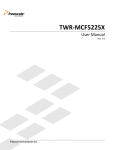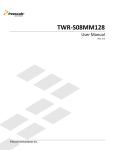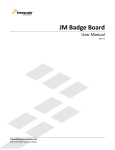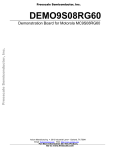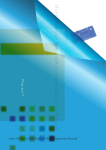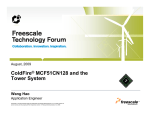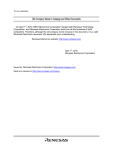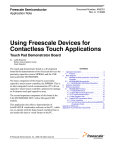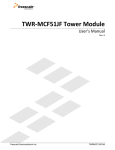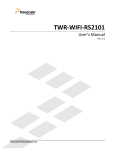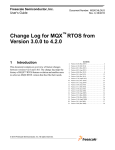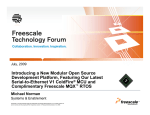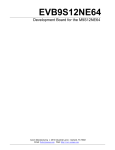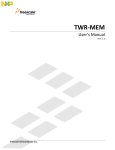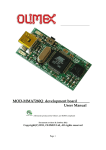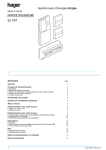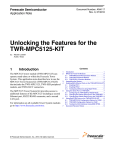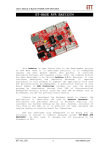Download TWR-MCF51CN
Transcript
TWR-MCF51CN User Manual Rev. 1.1 Freescale Semiconductor Inc. Microcontroller Solutions Group Contents 1 Overview ......................................................................................................................................................3 2 Reference Documents..............................................................................................................................4 3 Hardware Features...................................................................................................................................4 3.1 Clocking ..................................................................................................................................................................................4 3.2 System Power.......................................................................................................................................................................4 3.3 Debug Interface ...................................................................................................................................................................4 3.4 RS232 Interface...................................................................................................................................................................5 3.5 Elevator Connections ........................................................................................................................................................5 3.6 Mechanical Form Factor ..................................................................................................................................................5 4 Jumper Table ..............................................................................................................................................5 5 Input/Output Connectors and Pin Usage Table .............................................................................6 6 OSBDM...........................................................................................................................................................7 6.1 Bootloader Mode ................................................................................................................................................................7 6.2 Stand-Alone Debug Interface.........................................................................................................................................7 Revision History Revision 1.0 Date May 15, 2009 1.1 July 8, 2009 Changes Initial Release Added I/O Connector & Pin Usage table; added OSBDM section TWR-MCF51CN User’s Manual Page 2 of 8 1 Overview The MCF51CN Tower MCU Module (TWR-MCF51CN) is a low-cost evaluation, demonstration and development board. The TWR-MCF51CN can operate stand-alone or as the main control board in a Tower system with peripheral modules. The following list summarizes the features of the TWR-MCF51CN: • Tower compatible microcontroller module • MCF51CN128 in an 80 LQFP package • MC9S08JM60 based Open Source Debug (OSBDM) circuit • 4 user controlled LEDs • Two DIP Switches and three push buttons for user input • Potentiometer • MMA7260 three-axis accelerometer • RS232 transceiver and 2x5 pin header • Expansion via Primary Elevator connector A block diagram for the TWR-MCF51CN is shown in the figure below. Figure 1. TWR-MCF51JCN Block Diagram TWR-MCF51CN User’s Manual Page 3 of 8 2 Reference Documents The documents listed below should be referenced for more information on the Freescale Tower system and the TWR-MCF51CN. Refer to http://www.freesale.com/tower for the latest revision of all Tower documentation. • Freescale Tower Electromechanical Specification • TWR-MCF51CN Module Pinout • TWR-MCF51CN Schematics • TWR-MCF51CN Quick Start Guide • TWR-MCF51CN-KIT Lab Tutorial • MCF51CN128 Reference Manual • MCF51CN128 Data Sheet • AN3561, USB Bootloader for the MC9S08JM60 3 Hardware Features This section provides more details about the features and functionality of the TWR-MCF51CN. 3.1 Clocking Three options are provided for clocking the MCF51CN128 device: 1. 32.768 KHz crystal 2. 25 MHz crystal 3. External clock input from Primary Elevator (CLOCKIN0) Selection of the clock input is determined by the J11 and J12 settings. The 25 MHz crystal option is selected by default. Refer to Table 1 for more details. 3.2 System Power The TWR-MCF51CN can be powered by the OSBDM circuit via the Mini-B USB connector, J14, or a Functional Elevator via the Mini-B USB connector, J5. A standard USB A male to Mini-B male cable (supplied) can be used to supply power from a USB Host or powered USB Hub. Optionally, an AC to DC adapter with a USB A female receptacle (not provided) can be used as the power source. Power will automatically be sourced from the Elevator connector if power is available on both the Elevator and the OSBDM. A jumper, J6, can be used to isolate the 3.3V supply from the microcontroller. This connection can be used to measure the power usage of the MCF51CN microcontroller. 3.3 Debug Interface An on-board, MC9S08JM60 based Open Source BDM (OSBDM) circuit provides a debug interface to the MCF51CN. A standard USB A male to Mini-B male cable (supplied) can be used for debugging via TWR-MCF51CN User’s Manual Page 4 of 8 the USB connector, J14. Refer to section x for information on other modes of operation of the OSBDM. 3.4 RS232 Interface An RS232 transceiver on the TWR-MCF51CN connects to a standard 2x5 pin header. Selection jumpers J9 and J10 allow SCI1 signals to be routed to either the RS232 transceiver or the OSBDM circuit. Refer to Table 1 for more details. 3.5 Elevator Connections The TWR-MCF51CN features two expansion card-edge connectors that interface to Elevator boards in a Tower system: the Primary and Secondary Elevator connectors. The Primary Elevator connector, comprised of sides A and B, is utilized by the TWR-MCF51CN, while the Secondary Elevator connector only makes connections to ground (GND). The pinout details for the TWR-MCF51CN can be found in the TWR-MCF51CN Module Pinout document. 3.6 Mechanical Form Factor The TWR-MCF51CN is designed for the Freescale Tower system and complies with the electrical and mechanical specification as described in Freescale Tower Electromechanical Specification. 4 Jumper Table There are several jumpers provided for isolation, configuration, and feature selection. Refer to the following table for details. Table 1. TWR-MCF51CN Jumper Table Jumper Option J2 PTD7/RGPIO7/SPSCK2/ADP3 Usage Selection Setting 1-2 2-3 OFF 1-2 3-4 J3 Analog Isolation Jumpers: OFF setting isolates signals from Primary Elevator 5-6 7-8 9-10 11-12 13-14 Description Connect to DIP Switch Position 1 Connect to Potentiometer Only connected to Primary Elevator (SPI1_CLK, B7) Connect PTE2/KBI2P2/SS2/ADP0 to SPI1_CS0 (B9) and IRQ_D (B59) Connect PTE1/KBI2P1/MOSI2/ADP1 to SPI1_MOSI (B10) and IRQ_C (B60) Connect PTE0/KBI2P0/MISO2/ADP2 to SPI1_MISO (B11) and IRQ_B (B61) Connect PTD3/RGPIO3/RXD2/ADP4 to RXD1 (A43) Connect PTD2/RGPIO2/TXD2/ADP5 to TXD1 (A44) Connect PTD1/RGPIO1/RXD1/ADP6 to RXD0 (A41) and J10 Connect PTD0/RGPIO0/TXD1/ADP7 to TXD0 (A42) and J9 TWR-MCF51CN User’s Manual Page 5 of 8 1-2 3-4 5-6 7-8 J5 Peripheral Selection Jumpers 9-10 11-12 13-14 ON J6 MCU Power J9 UART TXD1 Routing Selection J10 UART RXD1 Routing Selection J11 EXTAL Selection J12 XTAL Selection J13 MiniBus Latch Enable J16 OSBDM Bootloader Select OFF 1-2 2-3 1-2 2-3 1-2 3-4 5-6 1-2 2-3 1-2 2-3 ON OFF Connect PTH3/FB_D6/TPM2CH0 to LED4 Connect PTE5/KBI2P5/IRQ/TPM1CH2 to LED3 Connect PTG5/KBI1P5/FB_D3 to LED2 Connect PTE3/KBI2P3/TPM1CH0 to LED1 Connect PTE0/KBI2P0/MISO2/ADP2 to Accelerometer Z-axis Connect PTE1/KBI2P1/MOSI2/ADP1to Accelerometer Y-axis Connect PTE2/KBI2P2/SS2/ADP0 to Accelerometer X-axis Supply 3.3V to MCU Isolate MCU from Power (current measurement option) Route TXD1 to RS232 transceiver Route TXD1 to OSBDM Route RXD1 to RS232 transceiver Route RXD1 to OSBDM 25MHz Crystal 32.768KHz Crystal CLOCKIN0 from Primary Elevator (B24) 25MHz Crystal 32.768KHz Crystal Latch Disabled Latch Enabled Bootloader mode Debugger mode 5 Input/Output Connectors and Pin Usage Table The following tables provides details on which MCF51CN pins are using to communicate with the TWRMCF51CN sensors, LEDs, switches, and other I/O interfaces. Table 2. I/O Connectors and Pin Usage Table TWR-MCF51CN I/O Component I/O Label SW1-1 Dip Switch SW1-2 SW2 Push Button SW3 SW4 (RST) LED1 LED2 LED LED3 LED4 X_OUT Accelerometer Y_OUT MMA7260QT Z_OUT Potentiometer POT Default Function PTD7/ RGPIO7 PTH2 PTG6 PTG7 RESETB PTE3 PTG5 PTE5 FTH3 PTE2 PTE1 PTE0 PTD7/ RGPIO7 MCF51CN128 Alternate 1 Alternate 2 Reserved SPSCK2 Reserved FB_D7 KBI1P6 FB_D2 KBI1P7 FB_D1 PTC3 Reserved KBI2P3 Reserved KBI1P5 FB_D3 KBI2P5 IRQ Reserved FB_D6 KBI2P2 SS2B KBI2P1 MOSI2 KBI2P0 MISO2 Reserved SPSCK2 TWR-MCF51CN User’s Manual Alternate 3 ADP3 TMRCLK1 Reserved Reserved Reserved TPM1CH0 Reserved TPM1CH2 TPM2CH0 ADP0 ADP1 ADP2 ADP3 Page 6 of 8 RS232 ICL3232 OSBDM USB to Serial T1IN R1OUT TXD1 RXD1 PTD0/ RGPIO0 PTD1/ RGPIO1 PTD1/ RGPIO1 PTD0/ RGPIO0 Reserved Reserved Reserved Reserved TXD1 RXD1 RXD1 TXD1 ADP7 ADP6 ADP6 ADP7 Note: Refer to Section 2.3, Pin Mux Controls, in MCF51CN128 Reference Manual to configure pin to appropriate alternate function. All pins default to Default Function out of reset. 6 OSBDM 6.1 Bootloader Mode The MC9S08JM60 device used in the OSBDM circuit is preprogrammed with OSBDM debugger firmware and a USB Bootloader. Jumper J16 determines which application will run following a poweron reset. If Bootloader Mode is chosen (jumper ON J16), the bootloader will be executed, allowing incircuit reprogramming of the JM60 flash memory via USB. This enables the OSBDM firmware to be upgraded by the user when upgrades become available. For details on the USB Bootloader, refer to Application Note AN3561 on the Freescale website (http://www.freescale.com). The USB Bootloader communicates with a GUI application running on a host PC. The GUI application can be found on the Freescale website; search keyword “JM60 GUI”. Refer to section 2.5 and 3.3 of AN3561 for details on installing and running the application. Note: The JM60 GUI Installer should be run before connecting the OSBDM in Bootloader Mode to a host USB port. Otherwise, the JM60 USB device will not be recognized and the proper drivers will not be loaded. 6.2 Stand-Alone Debug Interface The OSBDM circuit is designed so that it can program the on-board MCF51CN device, or be isolated from the on-board circuitry and be used as a programmer for other ColdFire V1 devices. The steps necessary to operate the OSBDM in this mode are listed here: 1. Remove 0 ohm resistor, SH1 2. Connect J8 (2x3 header) from TWR-MCF51CN to target debug connector TWR-MCF51CN User’s Manual Page 7 of 8 Freescale™ and the Freescale logo are trademarks of Freescale Semiconductor, Inc. All other product or service names are the property of their respective owners. © Freescale Semiconductor, Inc. 2009. All rights reserved. TWR-MCF51CN User’s Manual Page 8 of 8









